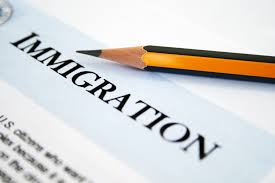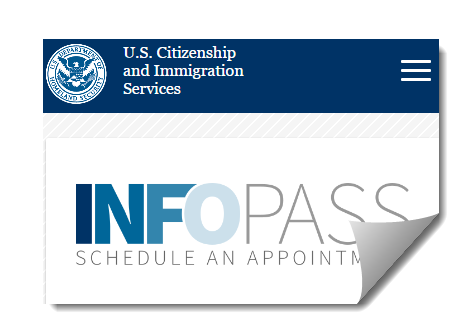POSTING DATE: March 4, 2019
Learn More About:
Immigration News & Updates eNewsletter © 2011 - 2019
For questions about U.S. Residency, Green Cards and Immigration Visas, Visit our Website at: www.ImmigrateToday.com or call our office at: (954) 382-5378
Check Out This Cool Stuff For Immigrants....
Immigration
Questions & Answers
This Week's Immigration News
Question: I have a question about my 2 kids, ages 13 and 17, living in jamaica. I started the filing and was contacted by national visa center with a list of documents I need to give them. I am trying to get the documents together, but I don't know how to go about sending the original documents. I only have one of each original documents, like the divorce, birth certificate and marriage certificates and if I need originals for both my kids I wont have them. I have copies but I would like to know if I should send the originals. Thank you very much I am awaiting your reply.
Answer: Don’t worry, these days, you only need to send the National Visa Center COPIES, no originals. You children will need to take the originals with them to their consular appointment. I hope this is helpful to you!
Helpful Immigration Tips You Can Use...
Immigration News & Updates eNewsletter
eNewsletter
Warning - Fake Marriage Is a One Way Ticket To Deportation Hell!
Most immigrants know at least one person that got their residency (Green Card) through a fake marriage to a U.S. Citizen or Cuban national. What most do not know is that for every person who is successful, ten or more are not and end up being deported. The most important thing to understand about obtaining a Green Card through marriage is that it is all or nothing! The Immigrant either receives conditional and then permanent residency or they don’t and are put in Removal proceedings. There are no other options.
Overview of the Naturalization Process - Becoming a U.S. Citizen
Since Trump was elected, millions of U.S. Residents (Green Card holders) have been scrambling to file for Naturalization, in fear of any new immigration policies he might apply to residents. As a result, waiting lines for naturalization processing are becoming longer and longer. The best advice is always to apply as early as possible when one becomes eligible. Here’s a brief overview of the process to Naturalize and the common steps to take once you become a U.S. Citizen:
1. Complete and file your Naturalization application (called form N-400) using Express or Priority Mail;
2. Receive a Receipt from the USCIS within about 10 days and go online and sign up for case updates on the USCIS website using the case number on your receipt;
3. Receive your Biometrics appointment notice within about 30 days from the USICS for you to go and have your fingerprints taken at the local USCIS office;
Common Immigration Filing Mistakes And How To Avoid Them
Immigration How To:
How Do I Know What Happens When I Apply For Citizenship
Filing an immigration application often means navigating a lengthy, often complicated process that nearly always involves multiple forms, lots and lots of paperwork, filing fees, fingerprints, background checks, an interview and possibly more. The process itself can be very stressful and seem overwhelming. And to make matters worse, making any mistakes along the way during this complex process can result in case delays, requests for additional evidence from the USCIS, denials, loss of filing fees, extended family separations and worse, even deportation.
With so much at stake for yourself or your loved ones, it is vital that any application made is properly filed the first time.
The good news is that many common mistakes are avoidable. Here’s a few of the most common mistakes that immigrants make and ways to avoid them:
Applying for an immigration status, you are not eligible for: The number one reason that immigrants receive denials is because they apply for a green card or work permit they are not eligible for. The filing of the application itself then triggers a denial and now more serious consequences which may lead to deportation from the U.S.. As a result, it’s always best to seek the advice of a qualified immigration attorney, not your mom or your friend, so you can get professional advice about your eligibility and what documentation you will need to provide in order to prove you qualify, even if you plan to do the case yourself.
Using outdated forms: Filing an application using outdated forms results in rejection, wasting time and postal fees. The best advice is always to go directly to the USCIS website, download and save the forms on your computer, then complete the forms and save them. If you complete a form without first downloading and saving it on your computer, you will not be able to save the information you have typed on the form and if you need to make any changes, you will have to redo the entire application all over again.
Filing the wrong form: This is common when renewing a green card, since there are two forms which seem to apply. For instance using form I-90 to renew a conditional two-year green card obtained through marriage, rather than the correct form I-751. This results in loss of the $540 filing fee, application denial and likely deportation, since failing to file the correct form I-751 to remove conditions on conditional residency prior to expiration results in loss of residency.
Submitting incomplete forms, those with illegible writing or incorrect information: Immigration forms request extensive information, even repetitive data which requires the same information from previous questions on the form or data from other forms to be submitted at the same time. It’s important to note that all the information requested must be written or typed in the space provided, even if the same information was previously provided on the same or other forms. Forms filed together may be processed separately, so missing information on a form may result in the USCIS issuing a request for evidence or even denying the application altogether. It’s always best to type the information on the forms, rather than handwriting it, however, if an immigrant does not have a computer and must complete the form by hand, written answers should be as clear as possible.
Finally, information provided on the form must be correct and accurate. Spelling your name wrong, omitting, or changing your legal name will result in delays and even denial. For instance, if the legal name on your birth certificate is Kathy Marie Jones, but you like to be called by your middle name Marie, so you write Marie as your first name and Jones as your last name, the USCIS will issue a request for you to prove that Marie Jones is your legal name. Similarly, if your last name is Lopez Ruiz, you cannot put your last name as just Lopez, since the name on the application must exactly match the name on your birth certificate or other legal documents, like a marriage certificate, which would prove a name change.
Failing to submit all pages of the form: Filing an application with missing pages often causes case rejection. This can happen when an immigrant determines that the information on the page does not apply, so they just omit the page. All immigration applications must be filed using the complete form (all pages) whether or not data on any particular page applies or not.
Filing an application package with missing forms: It’s very common with complex immigration applications like those for residency, where multiple forms are required, that an immigrant is not aware of exactly which forms must be included in the application package. For instance, in a typical marital residency case, forms I-130, I-130A, I-485, I-765, I-131 and I-864 are generally included, along with all the required financial and civil documentation as well.
If an application package is submitted without the form I-864 affidavit of support, the case is not complete and the USCIS officer will issue a request for the form to be provided. Similarly, while not required, if a residency case is filed without form I-765, the case will be processed, but the immigrant will never receive a work permit. The same is true for the form I-131 travel permit, which allows immigrants to return to the U.S. after travelling abroad while their residency application is pending.
Sending the wrong filing fee amount: Filing an application with the wrong filing fee amount results in case rejection. USCIS filing fees change from time to time, so before filing any immigration application, be sure to check the USCIS website for the current fee. Also, the USCIS recently launched an online tool in January for customers to use to properly calculate the correct fees for the forms being submitted. Note that when paying using a credit form, you must download and complete form G-1450 Authorization for Credit Card Transactions, complete and sign it and provide a separate form for separate applications, for instance the form I-130 filing fee is $535 and the form I-485 filing fees is $1,225 which includes filing fees for forms I-765 & I-131. If you only fill out one G-1450 for $1,760, your case will be rejected.
Failing to attach the required supporting documentation with your application: Every application requires the submission of documents to establish eligibility. This often includes copies of a naturalization certificate, birth certificate, passport, marriage certificate, divorce decree, translations for documents in a foreign language, tax, employment and proof of income and if applicable, criminal documentation (need copy of certified police report or ticket AND court disposition). If any one of these documents is not provided, the USCIS will issue a request for it, which will delay the case and failure to provide the documents by the deadline can result in denial. Only send copies of documents, DO NOT SEND ORIGINALS!
Failing To Send English Translations For Documents In A Foreign Language: Immigrants from non English speaking countries have their civil documents such as birth and marriage certificates and divorce decrees in their native language. Under USCIS rules, all documents submitted which are not in English must include a translation, along with a signed certificate of translation with the translator’s name, address and phone number, affirming that the person performing the translation is competent to translate from the foreign language into English and that the translation of the document is true and accurate to the best of the translator’s ability. Some applicants provide only the English translation and neglect to attach a copy of the original foreign language document, which results in a USCIS request for that document.
Failing to sign your application: Once the forms are properly completed, each form must be signed. Forms filed with the USCIS which are not signed will be returned and delay processing of the case.
Neglecting to review your forms and make copies before sending them off: It’s imperative to fully review each and every form before filing, to ensure that every question is answered completely and legibly and that all forms are signed and dated. Similarly, you should always make a complete copy of each and every document before sending to the USCIS including the mailing label. You will always need to refer to your application and all supporting documents in the future, so make sure you know exactly what you put on your forms and included in your application package.
Sending the package to the wrong location or using certified mail: One of the most common reasons for rejection is filing your application at the wrong USCIS address, so always visit the USCIS website prior to mailing your package to confirm the exact filing address. Another unnecessary reason for delays in filing is sending an application using certified mail, which is the slowest method you could possibly use. Instead, use Priority Mail, which only costs about $7, includes tracking and usually arrives to the USCIS in about 2-3 days, plus you get delivery notification. Using certified mail can take 7+ days or more!
Failing to sign up for e-notification and case status updates: These days, the USCIS has really made it easy to track receipt of your application, text you the case number and even let you sign up to receive automatic updates on your case! Therefore, there is no excuse not to take the additional step of signing up. To use the service, download and complete form G-1145 and put it on top of each application in your package, for instance, one for your form I-485, one for form I-765 and another for form I-131. That way you will receive a text or email with your case numbers, how convenient is that! Once you have your case numbers, go online to the USCIS website and sign up for automatic case updates using those case numbers.
Failing to change your address when you move: Forgetting to notify the USCIS of an address change is often the reason many cases are denied. Individuals file an application, which takes time to process, then move, don’t notify USCIS and so don’t receive any requests for information sent by the officer on the case and miss the deadline to provide the requested information. Similarly, when a case is approved and the applicant has moved, they never receive the approval notice.
The above are just several of the most common problems associated with applying for immigration benefits. Keep in mind that as with any complex process, like taxes, assistance from a professional, in this case a qualified immigration attorney is invaluable in avoiding mistakes, delays and denials and is much less expensive than you might imagine. Especially now, the cost is more than worth the potential negative consequences for yourself or your family if a case if filed improperly, leading to loss of filing fees, wasted time and even potential deportation.
USCIS Ends Infopass Appointment Self Scheduling
At Most South Florida USCIS Offices!
The USCIS has been making efforts during the past year to eliminate the Infopass system as we know it, which currently allows individuals to go online and schedule an appointment at their local USCIS office to speak to an information officer about their case.
But starting March 18, customers with applications pending in the Miami , Hialeah, Kendall and Oakland Park field offices will no longer be able to use that service. Under the new USCIS Information Services Modernization Program (ISMP) policy, which has been implemented at many USCIS offices nationwide, customers are will no longer be able to schedule Infopass appointments themselves and are instead required to call the USCIS 800# and request assistance.
The 800# USCIS officer will then make a determination as to whether or not an Infopass appointment can be scheduled. The USCIS tries to tout this ISMP initiative as providing better services to customers, when in fact, it is taking away an important tool which is very useful to customers, allowing them to sit down personally with a USCIS staff member at their local office, show documentation and request information about their case. I will keep you updated once the program is implemented with tips on navigating the new policy through the USCIS 800#.
What is Selective Service And What Happens
If You Fail To Register When Required?
Many Immigrants are not aware that the U.S. requires men to register for military conscription in case of war. Under U.S. law, men who live in the U.S. or who get a green card at any time between the ages of 18 and 26, are required to register with the U.S. Selective Service System, to be called up in a military draft if ever needed. Those exempt include men between 18 and 26 who were only here in a nonimmigrant visa status, like tourists, students, etc. Strangely, undocumented or illegal aliens are now required to register, although many do not.
The issue of Selective Service Registration generally comes up for male Immigrants who apply for Naturalization and are required to list their Selective Service Registration information. And since failing to register for Selective Service can result in Naturalization denial for failure to show good moral character, it’s a very important issue for those to whom it applies. For some, it’s not too late to register: Men preparing to apply for Naturalization (U.S. Citizenship) who failed to register for the Selective Service in the past, but who are not yet age 26, can still register online.
However, those who have passed age 26 are not eligible to register and must face the negative immigration consequences of passing the required registration date. For those who failed to register, the easiest thing to do may be to wait until you are age 31 to apply for Naturalization so that five years of good moral character have passed (or 29 years of age to show three years of “good moral character” for those who have been married to and living with a U.S. citizen).
Immigrants who failed to register, but don’t want to wait for the “good moral character” period to expire, need to provide the USCIS officer with documentation to demonstrate for instance that the Resident did not know he was supposed to register and did not “willfully” fail to do so. To do this, an Immigrant can submit the following along with his naturalization application:
1) Status Information Letter from the Selective Service System (obtained from the Selective Service System website or by calling 847-688-6888.)
2) Sworn Declaration, and sworn declarations from people who know the Immigrant, attesting to their knowledge of the reasons why he failed to learn about and did not know about the requirement to register or believed he was automatically registered.
USCIS officers have discretion whether or not to approve such cases, so it is best to provide as much evidence as possible to ensure the most positive result.
Question: In 2017 I filed for my citizenship and 2018 I took the test and passed it. But then I was supposed to go to take the oath and I was waiting for the date, but during that time I had moved, so I never got the notice. I went to check on the date last year and the immigration officer said the notice had been mailed to me last year right after the test. I explained that I never received it and he said I should have done and address change, but there was nothing he could do and I should refile my application. I don’t understand why I have to pay again for a new application when I was already approved and when it was not my fault since I moved and never got the notice. Can you help me?
Answer: I understand how frustrating it can be! However, since it was so long ago, your case might have been closed by the USCIS. It’s important to understand that all Immigrants are required to do an address change with the USCIS once they move. With all that said, in my experience there is one option you might try. Go to your local congressional office and request assistance. Explain that you did everything properly, but just did not get your Swearing In appointment notice due to the move. Ask that they make a special request for the USCIS to make an exception in your case and reschedule you for your swearing in ceremony. Be sure to bring your Naturalization receipt. I cannot guarantee it will work, but with some perseverance, you may have a chance. Good luck!
Question: me and my wife got married last year while she had her green card and last week she just got sworn as a US Citizen. How long do I need to wait before she can file my immigration papers for residency? Thank you.
Answer: Great news, there is no waiting period required before filing for your U.S. Residency. Your application can be filed the same day that your wife received her Naturalization Certificate! However, before filing, you must be sure that you are eligible for adjustment of status in the U.S. and that you have the proper documentation required by the USCIS.
Generally, as long as you entered the U.S. legally (and have your I-94 card), or if Canadian have your passport stamped, you are eligible to adjust status to U.S. Residency. There are exceptions, however, including those who enter the U.S. on C/D crewman visas. I hope this was helpful to you. If you would like for me to properly, prepare and file your Residency case for you, please come on in for a free consultation with me so I can explain the entire process to you in detail.
Once an Immigrant files for adjustment of status through marriage and attends the interview, there is no escape from the process. If the couple does not do well at the interview, does not have many marital documents, lives with relatives, no joint bank accounts which show movement, etc, a follow-up interview is scheduled many months down the road. At this second interview, often the U.S. Citizen or Cuban national is taken in with the officer alone and requested to sign a paper that the marriage is fake, withdraw the petition and not to tell the Immigrant. The Immigrant later receives a denial in the mail and referral to Immigration court for removal from the U.S.. There are no options to marry another U.S. Citizen and obtain residency or to be sponsored by a relative or even employer – NOTHING.
If the couple passes the marriage interview and the Immigrant spouse is issued two year conditional residency, this is only the beginning. 90 days before the two year residency mark, the couple must file a petition to remove the conditions on residency (form I-751) to make it permanent and for that, the couple must provide EXTENSIVE documentation to prove that they continue to live together in a “bona fide” (real) marriage. In recent years, the USCIS has become very strict about marital documentation, requiring hundreds of documents showing joint tax returns, bank statements, car insurance, utilities, etc. Those who live with relatives, don’t have joint bank accounts and utilities and are unable to provide the required documents are scheduled for a second interview, sometimes referred to as a “fraud” interview, for and officer to interrogate the couple and determine whether the marriage is real. If the officer determines that the couple is genuinely in a continuing marital relationship, permanent residency is approved and as long as the couple continues as such, the Immigrant spouse can apply for early Naturalization, once he or she has held residency status for two years and nine months. Additional marital documents proving the couple continues to reside together are required at the Naturalization interview as well.
What happens if the couple breaks up before the marriage interview? In most cases now days, if the Immigrant spouse attends the interview alone the officer will deny the case and the Immigrant will be referred to Immigration court for removal from the U.S..
What if the couple breaks up after the Immigrant spouse receives two year conditional residency? In that case, the Immigrant can file the removal of conditions application requesting a waiver of the joint filing requirement and submit EXTENSIVE documentation to prove the marriage was real, even though the couple is no longer together. In fake marriages, the couple never has much if any documents, so most of these cases are denied. Once the case is denied, the Immigrant is referred to Immigration court for removal from the U.S.. There are no options to marry another U.S. Citizen and obtain residency or to be sponsored by a relative or even employer. Once the USCIS denies a residency case based upon fraud, the door closes and there is no way to receive any legal status in the U.S. ever again.
But of course, removal proceedings take time, years in fact, so many Immigrants in the process go on with their lives, fall in love, get married and have kids, believing that they will be able to avoid deportation because they are now in a real relationship. However, immigration regulations specifically say otherwise and will not reward an Immigrant who engaged in a fake marriage previously, but who now has a genuine relationship and wants to use it to obtain residency again. It is very sad and tragic that families are broken up every day as part of this process. I would liken filing for residency based upon a fake marriage to taking heroin, once you do it, you can never go back. So don’t listen to well-meaning friends and family who say fake marriage is the best way to get a Green Card. Instead, just imagine that you will be taking your whole potential lifetime here in the U.S. full of hopes, dreams and possibilities, walking into a casino and betting it all on one number. Feeling that lucky?
4. Receive your Naturalization Interview notice in about 3 months, attend your interview, pass the test and get approved;
5. Receive your Naturalization Ceremony notice Once your Application for Naturalization is approved, the USCIS will schedule for your Naturalization Ceremony within about 30 days.
6. Attend your Naturalization Ceremony, surrender your Green Card, take your Oath of Allegiance to complete the process of becoming a U.S. citizen and receive your Naturalization Certificate the same day.
7. Apply for Your U.S. Passport Once you receive your Certificate of Naturalization, you can immediately apply for a U.S. passport. You will receive an application for a U.S. passport at your naturalization ceremony, called the “U.S. Citizenship Welcome Packet” or you can go online to the U.S. Passport office
8. Register to Vote! Once you are a U.S. Citizen, it is your right and privilege to vote. You can register to vote at certain locations in your community, which may include post offices, motor vehicle offices, county boards of election, and offices of your state Secretary of State. You can read more about registering to vote by reading the government publication: “A Voter’s Guide to Federal Elections."
9. Update your Social Security Record After you become a U.S. Citizen, you will need to notify the Social Security Administration (SSA) to update your Social Security record. You can find your local Social Security office by calling 1-800-772-1213 or by visiting: www.socialsecurity.gov. You can go to your local SSA office about ten days after your ceremony to give time for the SSA to be able to access your new status in the USCIS records. Be sure to take your Certificate of Naturalization or U.S. passport with you. Good luck!













